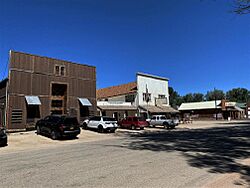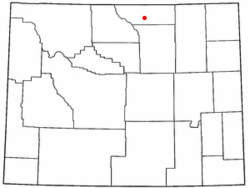Big Horn, Wyoming facts for kids
Quick facts for kids
Big Horn
|
|
|---|---|

Johnson Street in Big Horn
|
|

Location of Big Horn, Wyoming
|
|
| Country | United States |
| State | Wyoming |
| County | Sheridan |
| Government | |
| • Type | Unincorporated |
| Area | |
| • Total | 1.8 sq mi (5 km2) |
| • Land | 1.8 sq mi (5 km2) |
| • Water | 0.0 sq mi (0 km2) |
| Elevation | 4,062 ft (1,238 m) |
| Population
(2020)
|
|
| • Total | 457 |
| • Density | 254/sq mi (98.0/km2) |
| Time zone | UTC-7 (Mountain (MST)) |
| • Summer (DST) | UTC-6 (MDT) |
| ZIP code |
82833
|
| Area code(s) | 307 |
| FIPS code | 56-06770 |
| GNIS feature ID | 1585474 |
Big Horn is a small community in Sheridan County, Wyoming, United States. It's called a census-designated place (CDP) because it's a community that the government counts for population, but it's not officially a town or city. In 2020, about 457 people lived there.
Contents
History of Big Horn
Big Horn is located in a valley next to Little Goose Creek. Long ago, from 1866 to 1868, a military shortcut of the Bozeman Trail passed through this area. This trail was used by people traveling to find gold in Montana. However, Native American tribes, especially the Lakota led by Red Cloud, often attacked travelers on the trail.
A fort called Fort Phil Kearny was built nearby. But the attacks continued, so the U.S. Army left the area. This happened after the Fort Laramie Treaty of 1868.
A local historian named Glenn Sweem said the main Bozeman Trail didn't actually go right through where Big Horn is now. It went a bit to the east. It followed Prairie Dog Creek and then went through what is now 5th Street in Sheridan.
Little Goose Creek was also important during battles. In 1876, General George Crook set up his camp there. This was after a fight with the Sioux and Cheyenne tribes called the Battle of the Rosebud. While General Crook was fishing, General Custer and his soldiers were defeated. This happened at the Battle of the Little Bighorn, which was about 70 miles (110 km) north.
The first person to settle in the Big Horn area was Oliver Perry Hanna in 1878. He was an adventurer who hunted buffalo and fought in battles. He built a cabin on Hanna Creek. During one winter, he rode his horse to hunt buffalo in the Yellowstone River Country. He saw huge amounts of buffalo hides being shipped away.
After buffalo hunting ended, Hanna traveled 400 miles (640 km) to get seeds and a plow. He became the first farmer in what is now Sheridan County. Hanna helped attract many of the first settlers to Big Horn City, which started in 1882. He ran a hotel called the Oriental Hotel for many years.
Some local stories say that famous outlaws like Frank James and Big Nose George hid out near Little Goose Creek in 1878. People say they met Oliver Hanna. Another story is about a mysterious man who worked for the Hilman family. They thought he might be Butch Cassidy because of a note he left. These stories are part of local legends.
Polo was first played in the area in 1893 during a summer fair in Sheridan. Some players were from the English Cavalry. They had learned polo in India and brought the game to Wyoming.
At one time, Big Horn was much bigger, with almost 1,000 people. It had a college, a brick factory, a newspaper, churches, a hotel, and stores. It even tried to become the main town of Sheridan County. But in 1888, Sheridan won that title. Many people and businesses moved away from Big Horn around 1891. This happened when they found out the railroad was going to Sheridan instead. Since the railroad arrived in Sheridan in 1893, Big Horn has been a smaller community nearby.
Today, Big Horn still has a store, two bars, and places to stay. It also has a women's club, the Bozeman Trail Museum, a park, and an art museum. In 1984, Queen Elizabeth II of England even stayed in Big Horn. She visited her friends at the Canyon Ranch.
Geography and Climate
Big Horn is located on the eastern side of the Big Horn Mountains. It sits along Little Goose Creek, which flows into the Tongue River.
The area of Big Horn is about 1.8 square miles (4.7 square kilometers). All of this area is land.
Climate in Big Horn
Big Horn has a semi-arid climate. This means it's usually dry, but not a desert. It gets some rain and snow.
| Climate data for Big Horn, Wyoming, 1991–2020 normals, extremes 2000–present | |||||||||||||
|---|---|---|---|---|---|---|---|---|---|---|---|---|---|
| Month | Jan | Feb | Mar | Apr | May | Jun | Jul | Aug | Sep | Oct | Nov | Dec | Year |
| Record high °F (°C) | 71 (22) |
73 (23) |
79 (26) |
86 (30) |
94 (34) |
102 (39) |
102 (39) |
101 (38) |
99 (37) |
91 (33) |
78 (26) |
74 (23) |
102 (39) |
| Mean maximum °F (°C) | 60.1 (15.6) |
58.4 (14.7) |
70.9 (21.6) |
77.8 (25.4) |
83.4 (28.6) |
91.4 (33.0) |
97.0 (36.1) |
97.0 (36.1) |
92.5 (33.6) |
81.7 (27.6) |
71.5 (21.9) |
61.3 (16.3) |
98.5 (36.9) |
| Mean daily maximum °F (°C) | 37.7 (3.2) |
38.0 (3.3) |
47.6 (8.7) |
54.5 (12.5) |
63.7 (17.6) |
74.1 (23.4) |
84.0 (28.9) |
83.8 (28.8) |
73.5 (23.1) |
58.8 (14.9) |
46.4 (8.0) |
37.7 (3.2) |
58.3 (14.6) |
| Daily mean °F (°C) | 26.3 (−3.2) |
26.3 (−3.2) |
35.3 (1.8) |
42.8 (6.0) |
51.9 (11.1) |
61.1 (16.2) |
69.2 (20.7) |
68.4 (20.2) |
59.0 (15.0) |
45.6 (7.6) |
34.4 (1.3) |
25.7 (−3.5) |
45.5 (7.5) |
| Mean daily minimum °F (°C) | 14.9 (−9.5) |
14.5 (−9.7) |
23.0 (−5.0) |
31.1 (−0.5) |
40.1 (4.5) |
48.2 (9.0) |
54.4 (12.4) |
53.0 (11.7) |
44.5 (6.9) |
32.5 (0.3) |
22.4 (−5.3) |
13.7 (−10.2) |
32.7 (0.4) |
| Mean minimum °F (°C) | −11.6 (−24.2) |
−8.8 (−22.7) |
3.2 (−16.0) |
14.1 (−9.9) |
27.8 (−2.3) |
35.8 (2.1) |
44.5 (6.9) |
41.6 (5.3) |
30.4 (−0.9) |
14.0 (−10.0) |
0.1 (−17.7) |
−8.6 (−22.6) |
−17.1 (−27.3) |
| Record low °F (°C) | −20 (−29) |
−27 (−33) |
−18 (−28) |
−2 (−19) |
10 (−12) |
29 (−2) |
40 (4) |
34 (1) |
16 (−9) |
−7 (−22) |
−16 (−27) |
−28 (−33) |
−28 (−33) |
| Average precipitation inches (mm) | 0.60 (15) |
0.62 (16) |
1.77 (45) |
2.42 (61) |
3.79 (96) |
2.30 (58) |
0.95 (24) |
1.06 (27) |
1.70 (43) |
1.95 (50) |
0.85 (22) |
0.58 (15) |
18.59 (472) |
| Average snowfall inches (cm) | 11.4 (29) |
16.1 (41) |
13.6 (35) |
10.2 (26) |
2.0 (5.1) |
0.0 (0.0) |
0.0 (0.0) |
0.0 (0.0) |
1.0 (2.5) |
6.2 (16) |
9.2 (23) |
11.7 (30) |
81.4 (207.6) |
| Average precipitation days (≥ 0.01 in) | 7.3 | 9.0 | 8.4 | 10.9 | 14.6 | 10.4 | 7.3 | 6.9 | 7.3 | 10.3 | 6.8 | 6.4 | 105.6 |
| Average snowy days (≥ 0.1 in) | 7.2 | 9.4 | 5.6 | 4.3 | 0.9 | 0.0 | 0.0 | 0.0 | 0.3 | 2.5 | 4.6 | 6.7 | 41.5 |
| Source 1: NOAA | |||||||||||||
| Source 2: National Weather Service (mean maxima and minima 2006–2020) | |||||||||||||
People in Big Horn
| Historical population | |||
|---|---|---|---|
| Census | Pop. | %± | |
| 2000 | 198 | — | |
| 2010 | 490 | 147.5% | |
| 2020 | 457 | −6.7% | |
In 2000, there were 198 people living in Big Horn. By 2020, the population grew to 457. Most people living in Big Horn are White. A small number are Native American or from two or more races. Some people also have Hispanic or Latino backgrounds.
Many households in Big Horn have children under 18. Most families are married couples living together. The average age of people in Big Horn is about 40 years old.
Culture and Community
Big Horn was founded in 1882. Over time, wealthy cattle and sheep ranchers moved to the area. These included families from England and Scotland. They lived alongside other residents who owned smaller farms and ranches. This mix of people continues today. Many residents work in nearby Sheridan, Wyoming.
The large ranches near the mountains have mostly stayed the same. This is because some residents have worked to protect their land from being developed.
From fall to spring, much of the community's life happens around the K-12 school. Football season is especially popular! In the summer, Big Horn attracts polo players from all over the world. They enjoy the relaxed atmosphere of the Big Horn Polo and Flying H Polo Club. In May, the Big Horn Equestrian Center hosts a big soccer tournament. They turn three polo fields into 18 soccer fields for the event!
Even though Big Horn is not an official town, it has many community groups. These include a volunteer fire department, a church, a Women's Club, and a Lion's Club. The Big Horn City Historical Society has over 400 members across the country.
Flying H Polo Club
The Flying H Polo Club is one of the oldest polo clubs in the western United States. Polo came to the area in the 1890s. British people who settled on local ranches brought the sport with them. These men, like Oliver Wallop, started breeding polo ponies and holding matches.
A special polo culture grew here. Local cowboys played the game alongside the sons of wealthy families. In the early 1980s, the Big Horn Equestrian Center opened. Today, polo matches are held throughout the summer. Different local teams compete, usually on Sundays.
Schools in Big Horn
Children in Big Horn go to public schools run by Sheridan County School District #1.
Big Horn has one school campus for all grades, from kindergarten to 12th grade. About 400 students attend the school. Each graduating class has around 40 students. Students in Big Horn often get very high scores on tests. This is because of small class sizes, great teachers, and a community that cares about education. Many graduates go on to college and advanced studies. Big Horn schools are also known for their strong sports teams. They have won many state championships in football, volleyball, and girls' basketball.
Big Horn School has a four-day school week. Classes run from 8 am to 4 pm, and Fridays are for teacher training. This schedule helps teachers improve their skills. It also means students don't miss school for sports or other activities on Fridays. Plus, it gives kids a consistent three-day weekend to spend time with their families.
In 2009, plans were approved to build new school buildings in Big Horn. A new two-story middle school and high school was finished in 2010. A new elementary school will also be built where the old middle school and high school used to be.
See also
 In Spanish: Big Horn (Wyoming) para niños
In Spanish: Big Horn (Wyoming) para niños


